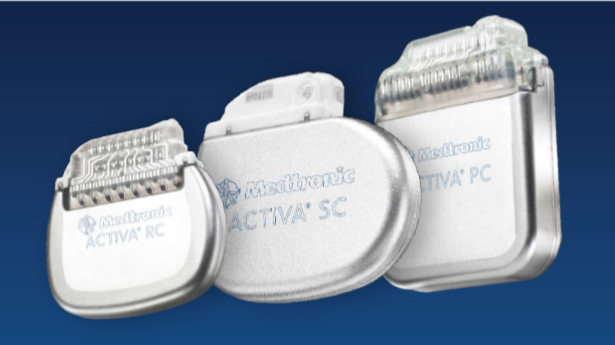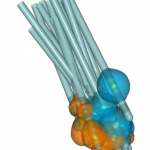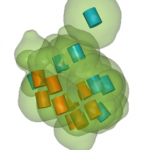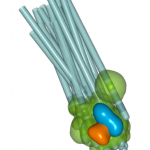The following article, makes reference to certain companies and their products and any opinions expressed should not be taken to be the views of Dystonia Europe or its members.
The articles are written by respected authors and are provided for the information of Dystonia Europe News readers.
Deep Brain Stimulation (DBS) is an established therapy for primary generalized and cervical dystonia, with an average dystonia score improvement of 50-60% as demonstrated in the literature1-5.
The factors that contribute to the therapy outcome are: patient selection criteria, variability in electrode placement and stimulation settings. The search for optimal stimulation parameters is complicated by the fact that stimulation-induced effects onset with a significant delay6.
A recent multicenter study conducted by Dr. Reich and colleagues (Julius-Maximilians-University Würzburg, Germany, https://visualdbslab.com) presents a novel method for contact selection based on probabilistic stimulation maps7. The outcome of DBS therapy in 87 dystonia patients was analyzed and the volume of stimulation was aggregated into 4 outcome groups. The average improvement of dystonia motor score was 50.5 ± 30.9% in cervical and 58.2 ± 48.8% in generalized dystonia, while 19.5% of patients did not respond to treatment (<25% benefit).
There was a significant correlation between the dystonia score improvement and the anatomical area of stimulation. The highest motor function improvement could be found in a small region covering the ventroposterior globus pallidus internus (GPi) and adjacent subpallidal white matter.
Probabilistic stimulation maps were based on lead location and the volume of tissue activated with the help of SureTune™ software (Medtronic PLC). The stimulation volumes were subsequently normalized into common space followed by voxel-wise ranking for outcome distribution using a self-programmed MATLAB tool. The resulting probabilistic maps were used to predict individual outcomes in DBS dystonia patients showing robustness between the predicted and the observed clinical improvement. The predictions deviated on average by 16.9 ± 11.6% from the observed clinical improvement.
As per the authors, these results emphasize the potential of applying probabilistic stimulation maps in the search for optimal therapeutic volume for pallidal neurostimulation. This technique is a topic of interest for computer-assisted planning and programming of deep brain stimulation.
Medtronic helped pioneer DBS, and more than 150,000 patients worldwide have received Medtronic DBS Therapy TODAY.
Medtronic Activa Portfolio, tailored to each individual’s need.

See the device manual for detailed information regarding the instructions for use, the implant procedure, indications, contraindications, warnings, precautions, and potential adverse events , If using an MRI SureScan® device, see the MRI SureScan® technical manual before performing an MRI. For further information, contact your local Medtronic representative and/or consult the Medtronic website at medtronic.eu.
References:
1 Isaias IU, Alterman RL, Tagliati M. Outcome predictors of pallidal stimulation in patients with primary dystonia: the role of disease duration. Brain 2008; 131 (Pt 7): 1895–902.
2 Volkmann J, Wolters A, Kupsch A, Muller J, Kuhn AA, Schneider GHet al. . Pallidal deep brain stimulation in patients with primary generalised or segmental dystonia: 5-year follow-up of a randomised trial. Lancet Neurol 2012; 11: 1029–38.
3 Volkmann J, Mueller J, Deuschl G, Kuhn AA, Krauss JK, Poewe Wet al. . Pallidal neurostimulation in patients with medication-refractory cervical dystonia: a randomised, sham-controlled trial. Lancet Neurol 2014; 13: 875–84.
4 Bruggemann N, Kuhn A, Schneider SA, Kamm C, Wolters A, Krause Pet al. . Short- and long-term outcome of chronic pallidal neurostimulation in monogenic isolated dystonia. Neurology 2015; 84: 895–903.
5 Contarino MF, Smit M, van den Dool J, Volkmann J, Tijssen MA. Unmet needs in the management of cervical dystonia. Front Neurol 2016; 7: 165.
6 Kupsch A, Benecke R, Müller J, Trottenberg T, Schneider GH, Poewe W, Eisner W, Wolters A, Müller JU, Deuschl G, Pinsker MO. Pallidal deep-brain stimulation in primary generalized or segmental dystonia. New England Journal of Medicine. 2006 Nov 9;355(19):1978-90.
7 Martin M Reich, Andreas Horn, Florian Lange, Jonas Roothans, Steffen Paschen, Joachim Runge, Fritz Wodarg, Nicolo G Pozzi, Karsten Witt, Robert C Nickl, Louis Soussand, Siobhan Ewert, Virgina Maltese, Matthias Wittstock, Gerd-Helge Schneider, Volker Coenen, Philipp Mahlknecht, Werner Poewe, Wilhelm Eisner, Ann-Kristin Helmers, Cordula Matthies, Volker Sturm, Ioannis U Isaias, Joachim K Krauss, Andrea A Kühn, Günther Deuschl, Jens Volkmann, Probabilistic mapping of the antidystonic effect of pallidal neurostimulation: a multicentre imaging study, Brain, Volume 142, Issue 5, May 2019, Pages 1386–1398, https://doi.org/10.1093/brain/awz046



